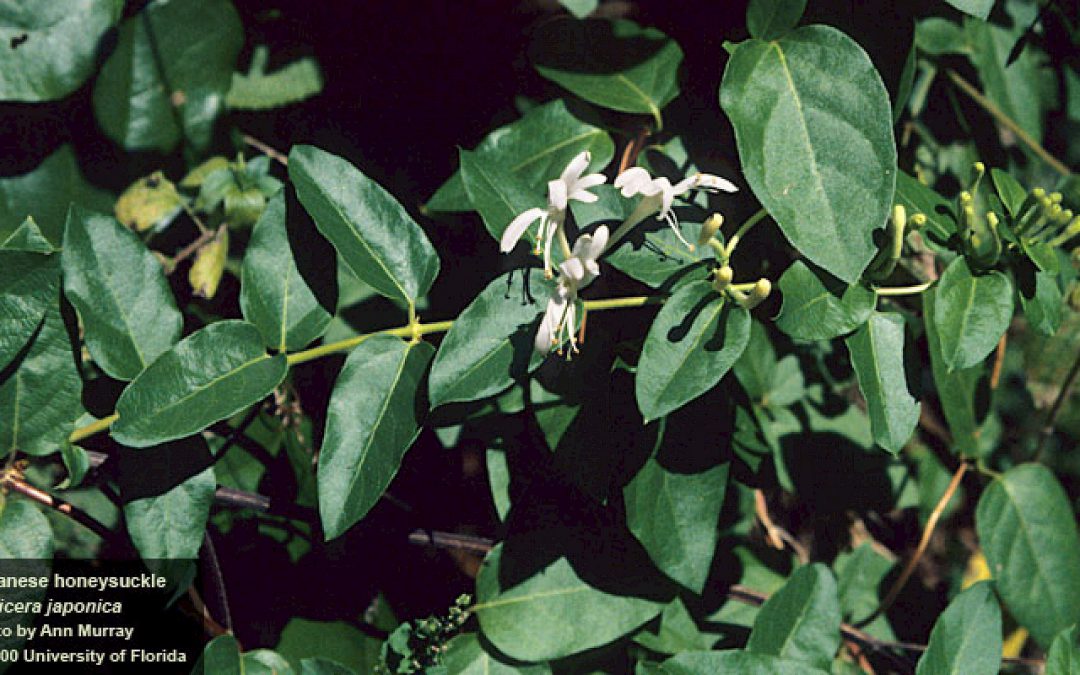
by Rick O'Connor | Feb 18, 2022
Six Rivers “Dirty Dozen” Invasive Species
Japanese Honeysuckle (Lonicera japonica)

Japanese Honeysuckle
Photo: University of Florida
Define Invasive Species: must have all of the following –
- Is non-native to the area, in our case northwest Florida
- Introduced by humans, whether intentional or accidental
- Causing either an environmental or economic problem, possibly both
Define “Dirty Dozen” Species:
These are species that are well established within the CISMA and are considered, by members of the CISMA, to be one of the top 12 worst problems in our area.
Native Range:
Japanese honeysuckle is native to China, Japan, and Korea.
Introduction:
Japanese honeysuckle was first introduced to Florida in 1875 for agricultural and gardening purposes. It was introduced as a forage plant in the agriculture industry and was very popular as a landscape plant due to its beautiful showy flowers. Its invasive nature was quickly discovered and is now listed as a Category I invasive plant and a Florida noxious weed.
EDDMapS currently has 115,101 records of this plant across the country. Most are east of the Mississippi River but cover the entire east coast, including New England. There are records in the southwestern part of the U.S. In Florida, most of the records are in the northern part of the state, particularly in the panhandle. There are few records south of Orlando. Within the Florida panhandle there are 1,558 records and 1,209 within the Six Rivers CISMA. As with most species, this is probably underreported.
Description:
Japanese honeysuckle is a woody vine that produces beautiful white flowers. These flowers have multiple sepals, and the stamens which extend outward resembling “whiskers”. The leaves are about 1-3 inches, ovate is shape, and opposite on the stem. The small fruits are green and hard when immature, black and soft when older.
Issues and Impacts:
This is an aggressive growing vine that can quickly take over the landscape. It can cover small shrubs and trees killing them, block sunlight so germination of other plants is impossible, and outcompete native plants for needed sunlight decreasing the biodiversity within the area.
Management:
Removing by hand or shovel is effective on small patches. Mowing small patches has found to reduce seed spread but the parent plant may return with additional stems. Mechanical tillage can be effective but can enhance seed dispersal from the seed bank and is not always an option in some locations.
Chemical treatment with either glyphosate or triclopyr has been effective however, cut stump application is recommended. Foliar sprays that do not reach ALL leaves can induce resprouting.
There are no known biological controls at this time.
For more information on this Dirty Dozen species, contact your local extension office.
References
Japanese Honeysuckle. University of Florida IFAS Center for Aquatic and Invasive Plants
https://plants.ifas.ufl.edu/plant-directory/lonicera-japonica/.
Lonicera japonica. University of Florida IFAS Assessment. https://assessment.ifas.ufl.edu/assessments/lonicera-japonica/.
Early Detection and Distribution Mapping System (EDDMapS)
https://www.eddmaps.org/
Six Rivers CISMA
https://www.floridainvasives.org/sixrivers/
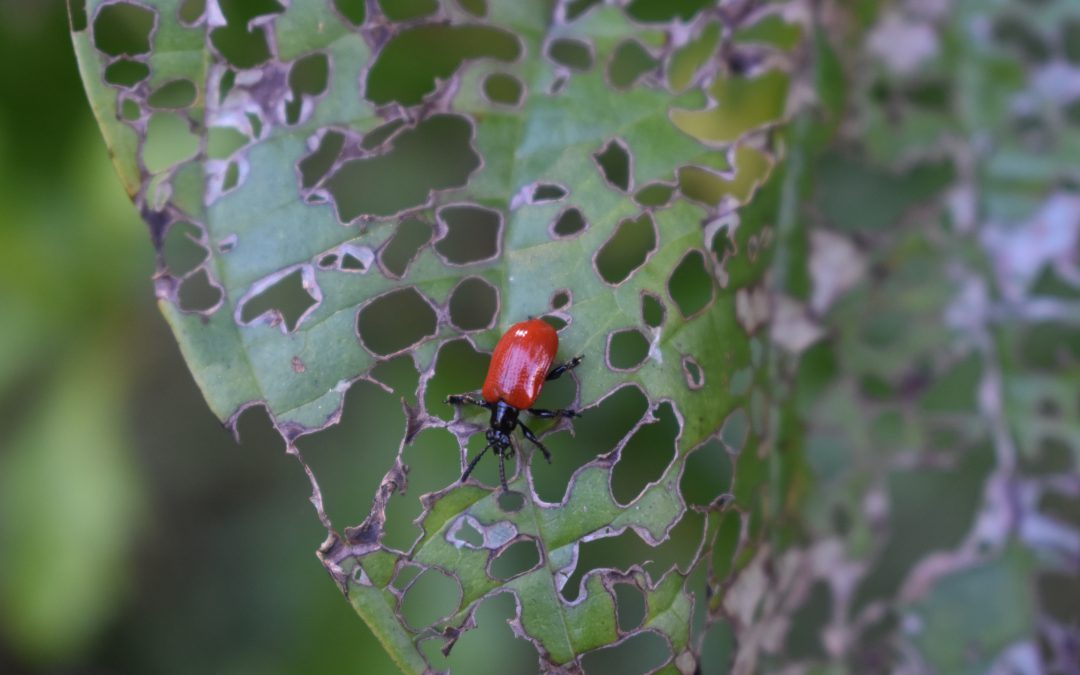
by Danielle S. Williams | Feb 3, 2022
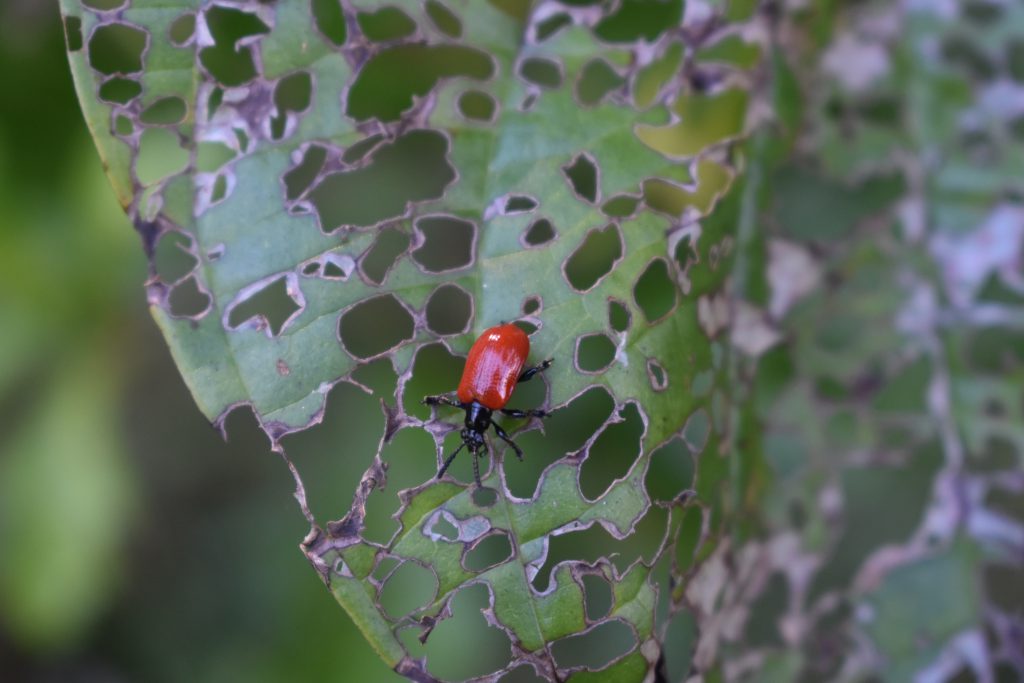
Air Potato Leaf Beetle
I’m sure many of you could easily recognize air potato with its winding vines and heart-shaped leaves climbing high along roadsides, fencerows and natural vegetation, but could you recognize its key predator, the air potato leaf beetle? Believe it or not, a small, red leaf-feeding beetle was introduced and is here to help control the invasive air potato vine!
The Issue with Air Potato Vine
Air potato (Dioscorea bulbifera) is a plant species that is native to Asia and was first introduced to the United States as a landscape plant but has now become one of Florida’s most problematic invasive plants. Air potato has spread to 60 of the 67 counties in Florida, including many in the Panhandle. Air potato vines can grow up to 8 inches per day! The dense vines smother vegetation and displace native plants, trees and animals. The air potato vine is on the Florida Noxious Weed List. This means that is illegal to plant, propagate or move the air potato unless you have a permit.
The air potato vine spreads by vegetative reproduction. This is through the formation of aerial tubers, or bulbils that are formed in the leaf axils. The aerial tubers are roundish and vary in size. In addition to aerial tubers, air potato also produces underground tubers, making control that much more difficult. During the winter, the aerial tubers will drop to the ground and give rise to new vines in the spring.
Park managers and homeowners throughout Florida have battled with the air potato as its covered our landscape. For years, the primary means of control were by manually pulling, digging and destroying the tubers or by herbicide applications, until recently.
Classical Biological Control of the Air Potato Vine
Another method for controlling invasive plants is with classical biological control. This method involves searching for insects that feed exclusively on a plant in its native range and releasing them in an area that has been invaded by the plant. Scientists with the United States Department of Agriculture discovered the air potato leaf beetle (Lilioceris cheni) that feeds on air potato in its native range of Asia. After extensive testing, scientist found that the beetle is species-specific and poses no risk to other plant species.
In 2012, air potato leaf beetles were first released in Florida to help battle the air potato. Now, according to the Florida Department of Agriculture and Consumer Services (FDACS), they are officially established in the state! This means, they are here to stay and research has shown they are helping!
While you likely won’t see the beetles now, because they are overwintering (a period of suspended development), look for them in the spring! Adults are bright red with a black head and legs and about the size of your pinky fingernail. The females lay white, pale eggs on the underside of leaves. The egg-laying process causes the leaves to curl and cup. In addition to that, larvae feed on the leaves skeletonizing them. This feeding by the beetle negatively affects the growth and reproduction of the plant.

Skeletonized leaf damage to Air Potato from the Air Potato Leaf Beetle. Photo: Danielle Sprague
For more information on air potato leaf beetles, please visit:
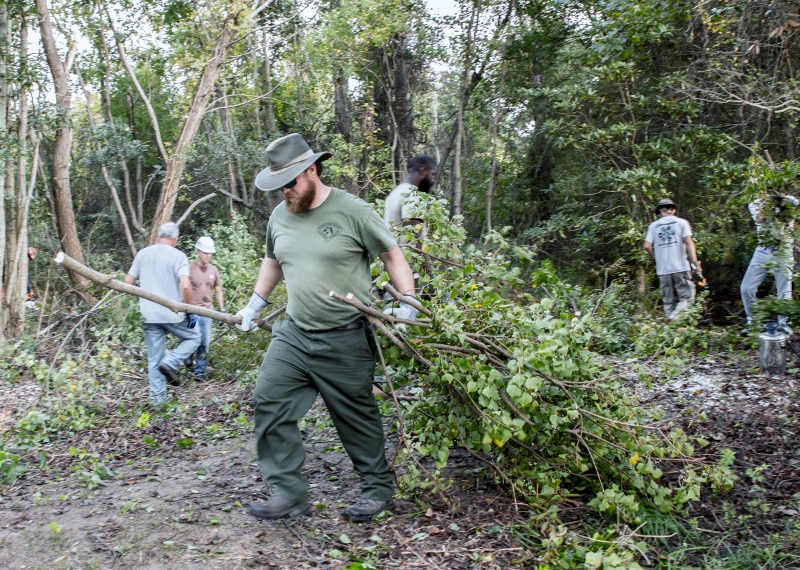
by Rick O'Connor | Jan 27, 2022
What is the Weed Wrangle?
It is a national event held every February where members of local communities visit a public area to remove invasive plants. However, due to COVID, we are again doing it “virtually” this year. Virtually meaning that members of the local community work in their own yards to remove invasive plants. This year in the western Florida panhandle we are targeting the Chinese tallow, but of course you are welcome to remove ANY invasive plant you may have.

The round-ish ovate leaves of the Chinese Tallow.
Photo: Rick O’Connor
How do you DO the Weed Wrangle?
Step 1 – Survey your property to see if you have any Chinese tallow. This tree is also known by many as the “popcorn tree”. You can work with other members on your street who are interested and identify Chinese tallow on your block.
Step 2 – Confirm the identification. If you are sure it is Chinese tallow, and many are very familiar with this plant and is why we have chosen it, you are good to go. If not, you can contact your county extension office for verification.
Step 3 – Report the tree(s) to the national database EDDMapS at www.EDDMapS.org. There is a “report sightings” button on the tool bar. It will ask for latitude and longitude and you can get this information from your phone or a GPS or from google earth if you have it on your computer. Remember to type in longitude as a negative number, -87 in our case, so that it is reported in the correct hemisphere. NOTE: You are not allowed to report plants on someone else’s property without their permission, please get that before you do.
Step 4 – Remove it. Please take photo of the tree(s) BEFORE you remove. Not everyone wants to remove their Chinese tallow. Even though it is an invasive species and listed as a state noxious weed. Many enjoy the tree, and the color changes it provides. There is nothing illegal about having the tree in your yard, so you are fine. If you do choose to remove it there are methods that have been tested that work best. Contact your county extension office for those methods so that you are successful. Please take photo after removal.
Step 5 – Contact me – Rick O’Connor, Escambia County Extension, at roc1@ufl.edu to let me know you which steps you completed. I am tracking participation in this years Weed Wrangle. We will be doing this during the month of February. We also can enter you into a drawing for prizes!
If there are other invasive plants on your property you are interested in removing and want to know the best methods to do so, contact your county extension office and we can provide that for you. It would certainly be included in this years Weed Wrangle.
Thanks for helping stay on top of our invasive species problem.

Members of the Six Rivers CISMA remove Chinese tallow from a city park in Pensacola.
Photo: Kristal Walsh.
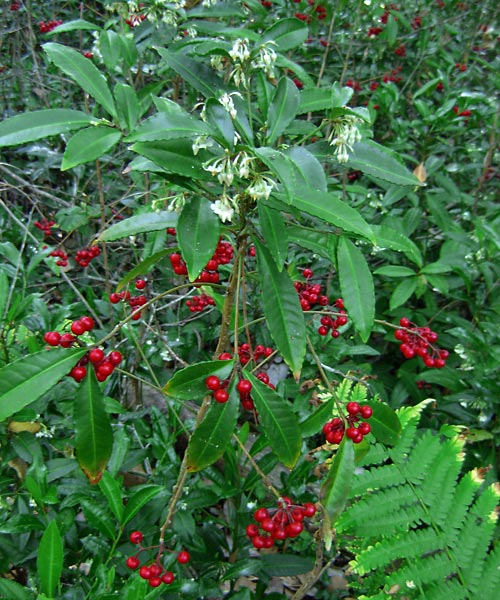
by Rick O'Connor | Jan 20, 2022
EDRR Invasive Species
Coral Ardisia (Ardisia crenata)

photo courtesy of Les Harrison
Define Invasive Species: must have ALL of the following –
- Is non-native to the area, in our case northwest Florida
- Introduced by humans, whether intentional or accidental
- Causing either an environmental or economic problem, possibly both
Define EDRR Species: Early Detection Rapid Response. These are species that are either –
- Not currently in the area, in our case the Six Rivers CISMA, but a potential threat
- In the area but in small numbers and could be eradicated
Native Range:
Japan and northern India
Introduction:
Was introduced intentionally as an ornamental plant in the early 1900s. In 1982 it escaped cultivation and spread through wooded areas of Florida and parts of the Gulf coast.
EDDMapS currently list 2,064 records of coral ardisia. Most are in Florida but there are records in the Gulf states, Georgia, and South Carolina. Records within Florida cover the state, but has not been reported from all counties.
Within Six Rivers CISMA there are 11 records including Baldwin, Santa Rosa, Okaloosa, and Holmes Counties.
Description:
Coral ardisia grows in clumps, many times multi-stemmed in wooded areas. It has long (8”) glossy leaves that are dark green in color and has scalloped margins. The flowers are whiteish pink and droop below the leaf cover. The fruit are bright red berries that also droop from the plant and are present much of the year.
Issues and Impacts:
Like many invasive plants, coral ardisia spreads aggressively replacing native plants where they can. Though no published literature, it is believed to be toxic to livestock, pets, and humans.
It is a Category I invasive plant and a Florida Noxious Weed. It is listed as prohibited by the UF IFAS Assessment.
Management:
Step 1 is to avoid planting coral ardisia in your landscape. It is listed as a Florida noxious weed, and thus should not be sold, but transplanting is prohibited. If it can be easily removed by hand from your landscape, do so before it goes to seed. Be careful not to spread seeds.
Disking and/or burning can be effective however (a) most areas where coral ardisia grows prohibits disking and/or burning and (b) unless you removed all of the deep rhizomes it may return, so annual surveys are still needed.
Chemical treatments typically use the active ingredient triclopyr. This herbicide can be applied directly to the leaves or by applying to the bark when the plant is relatively dry. For large areas needing treatment the formulas may change. Different mixtures can be found in the references below. Annual retreatment may be required. Contact your local county extension office if you have questions.
References
Ardisia crenata. 2022. University of Florida Center for Aquatic and Invasive Plants. https://plants.ifas.ufl.edu/plant-directory/ardisia-crenata/.
Ardisia crenata. 2019. University of Florida IFAS Assessment of Non-Native Plants. https://assessment.ifas.ufl.edu/assessments/ardisia-crenata/.
Sellers, B.A., Enloe, S.F., Minogue, P., Walter, J. 2021. Identification and Control of Coral Ardisia (Ardisia crenata): Potentially Poisonous Plant. University of Florida IFAS Electronic Digital Information System (EDIS) publication #SS AGR-276. https://edis.ifas.ufl.edu/publication/AG281.
Early Detection and Distribution Mapping System (EDDMapS)
https://www.eddmaps.org/
Six Rivers CISMA
https://www.floridainvasives.org/sixrivers/
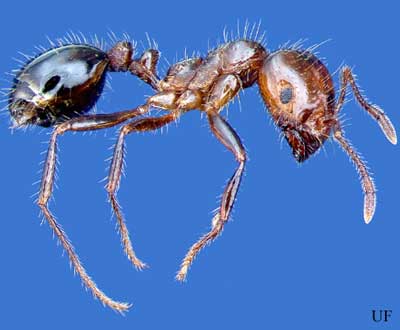
by Rick O'Connor | Dec 2, 2021
Six Rivers “Dirty Dozen” Invasive Species
Red Fire Ant (Solenopis invicta)

The red imported fire ant.
Photo: University of Florida Entomology and Nematology
Define Invasive Species: must have all of the following –
- Is non-native to the area, in our case northwest Florida
- Introduced by humans, whether intentional or accidental
- Causing either an environmental or economic problem, possibly both
Define “Dirty Dozen” Species:
These are species that are well established within the CISMA and are considered, by members of the CISMA, to be one of the top 12 worst problems in our area.
Native Range:
The red fire ant is a native of central South America.
Introduction:
It is believed the first red fire ants entered the U.S. from Brazil into either Mobile AL or Pensacola FL between 1933 and 1945 via ship. As of 2008 they had been reported in 16 states stretching from the east to the west coast, albeit mostly southern states.
EDDMapS currently list 799 records of red fire ants in the U.S. This is certainly well under reported. Most of these are from the southeastern United States (including Texas) and three records from the Washington/Oregon area. There are only 15 records from Florida, 6 from the panhandle, and no records within the Six Rivers CISMA. Again, this is significantly underreported to EDDMapS. It is a well-known species in our area.
Description:
The body of the red imported fire ant is red brown in color with a black gaster (tail). The thin/skinny “waist” has two segments. The mounds are usually of soil and, if disturbed, aggressively defended by the colony. They like well-manicured lawns and in Florida’s sandy soils, may not form the large mounds found in clay-based soils. They differ from the native fire ant (Solenopsis geminate) in that workers of the native species have enlarged square heads – not found in the invasive red imported fire ant.
Issues and Impacts:
The red imported fire ant has become a pest for agriculture and urban communities alike. They can cause both medical and environmental harm.
In agriculture the ant is known to infest soybean fields. Large infestations can lower crop yield, and some states report large infestations impacting the ability to use combines for harvest, reducing yield. One paper reported $156 million in losses with the soybean industry. The ants will feed on the young developing plants of not only soybean but okra, cabbage, citrus, corn, bean, cucumber, eggplant, potato, sweet potato, peanut, sorghum, and sunflower crops. They are also a pest for livestock.
In urban communities they will nest almost anywhere including sidewalks, lawns, driveways, mailboxes, along the sides of homes. During heavy rains they will seek higher ground sometimes entering houses and forming floating mats of live ants that have been problems after storm events. The sting is quite painful. Ants will both bite with their mandibles and inject a venom with a spine on their gaster. The venom is an alkaloid mixture that exhibits potent necrotoxic activity (destroys tissue). The reactions to fire ant stings vary depending on the individual from mild pain to anaphylactic shock. The actual medical cost from the fire ant invasion is unknown. Not only do they sting humans, but pets as well. Fire ants have been found in electrical systems and have caused short circuiting.
These ants have had an impact on native wildlife as well. Ground nesting birds and rodents will cease in areas where the ants colonize, and it is known that they have impacted the protected gopher tortoise populations.
Management:
There are two plans of attack on fire ant management but no long term effective method is known. (1) individual mounds, (2) wide area broadcast application.
Individual Mound
- Liquids poured over the mound can be effective. These liquids can be hot water or insecticide products mixed with water. There are numerous fire ant insecticides available. However, if the queen is not killed (living deep in the mound), recolonization is probable.
- Dusting involves sprinkling an insecticide dust over the mound, and then watering it in.
- Mound injections is an option. Here tools are used to inject the insecticide into the mound. This can be more expensive and hazardous to the handler.
- Baits can be placed on the mound where the colony spreads it through out. This can be very effective but slow going.
- There are certain mechanical and electrical devices on the market, but their efficacy is not well tested.
Some suggest that only 20% of a colony is feeding at any one time and that many insecticides are not as effective. The timing of the control is important. Comprehensive fire ant management information can be found in the Extension publication, Managing Imported Fire Ants in Urban Areas.
Broadcast Applications
Most of the broadcast sprays involve baits or dust products. They can be effective but are often sprayed in locations where the ants cannot find them or become inactive by the time they do.
Biological Control
Biological controls using native predators must be tested to assure they do not have a negative impact on the native flora and fauna. Two potential biological controls, a protozoan and a fungus, are currently being tested along with others.
Phorid flies (which are parasites on fire ants) have been released in the southeast U.S. by the USDA. These colonies of flies have expanded beyond the area where they were released.
Home Remedies
Home remedies including club soda, grits, soap, wood ashes, and shoveling mounds together have shown to be ineffective.
For more information on this Dirty Dozen species, contact your local extension office.
References
Red Imported Fire Ant. Solenopsis invicta. Featured Creatures. University of Florida Entomology and Nematology. https://entnemdept.ufl.edu/creatures/urban/ants/red_imported_fire_ant.htm.
Fire Ants. University of Florida IFAS Gardening Solutions. https://gardeningsolutions.ifas.ufl.edu/care/pests-and-diseases/pests/fire-ants.html.
Fire Ants in Florida. University of Florida Blogs. https://sfyl.ifas.ufl.edu/lawn-and-garden/fire-ants-in-florida/.
Early Detection and Distribution Mapping System (EDDMapS)
https://www.eddmaps.org/
Six Rivers CISMA
https://www.floridainvasives.org/sixrivers/









